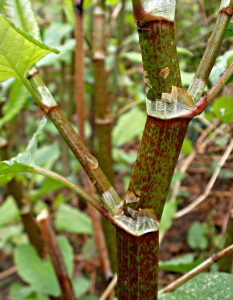
The Rideau River shoreline is an important recreational pathway and natural area that contributes greatly to the quality of life in Sandy Hill. Yet this critical green space is increasingly being taken over by invasive plants, shrubs and trees. Among the biggest culprits are Common Buckthorn, Dog Strangling Vine, Wild Parsnip and Japanese Knotweed. In spring 2021 the Sandy Hill Tree and Greening Group will undertake a new initiative focused on Japanese Knotweed. Even in winter you will see the bare, brittle, bamboo-like stems of this plant poking above the snow in dense stands along the riverbank behind Robinson Village and in several patches along the footpath and on the slope behind Range Road. You will also see a large infestation near the bottom of the toboggan hill in the northwest corner of Strathcona Park.
Japanese Knotweed is an aggressive, persistent invader in many countries outside its native range in northeast Asia. Having been transplanted beyond the reach of its natural enemies, it can grow unchecked, outcompeting native vegetation with its dense foliage and deep, extensive, and vigorous root system. If left uncontrolled it can form dense, pure stands that exclude all other plant life, particularly along streambanks, in wetlands and in moist soils along roads and pathways. Once established, it is extremely difficult to eradicate, so it is important to tackle new populations early.
The ASH Tree and Greening Group is currently mapping the extent of Japanese Knotweed infestation along the Rideau River shoreline and investigating the best practices to halt its spread. If you would like to help us, please send an email to sandyhilltreegroup@gmail.com. Please also keep an eye out for Japanese Knotweed in your own yard and neighbouring properties. You can find more information on this invasive plant at:
